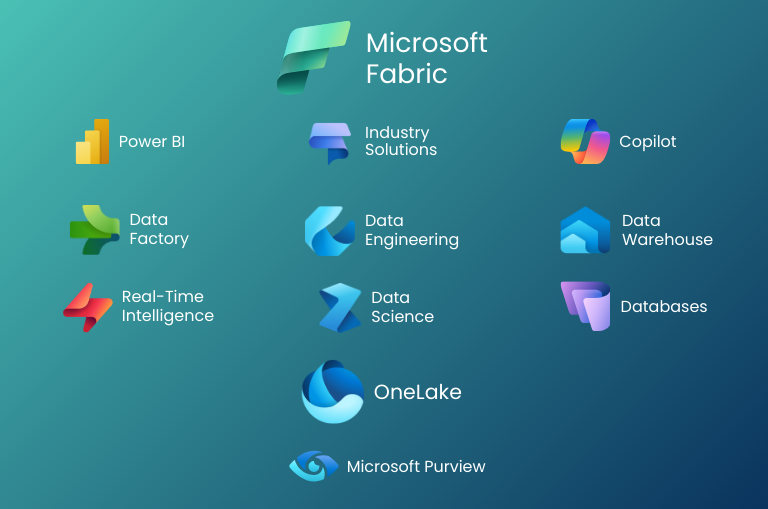SAP Business Data Cloud vs Microsoft Fabric: Data Platform Comparison
Modern data platforms, such as the advanced SAP Business Data Cloud solution and the versatile Microsoft Fabric platform, play a key role in transforming how organisations manage information.
They not only enable the transformation of raw, often dispersed data into structured and valuable information assets, but also provide advanced tools for their analysis and interpretation. As a result, enterprises gain the ability to make more informed and strategic decisions based on solid analytical foundations.
What are modern data platforms
A modern data platform is a comprehensive solution that enables management of the entire data lifecycle from acquisition, through storage and processing, to analysis and visualisation.
Unlike traditional systems, contemporary platforms offer scalability, flexibility, and advanced analytical functions, often using the cloud as the operating environment, eliminating the need to manage physical infrastructure.
What is SAP Business Data Cloud
SAP Business Data Cloud is a fully managed SaaS solution that unifies and oversees all SAP data, combining it with external entities’ data.
The platform harmonises critical business data, creating a trusted source of information essential for making accurate decisions and building reliable artificial intelligence.
The architecture of SAP Business Data Cloud includes source systems (SAP and non-SAP), Foundation Services, and SAP Datasphere. The platform integrates with Databricks, enabling advanced data engineering and machine learning.
Benefits include instant access to high-quality data without costly extraction and advanced real-time analytics.
Strengths
The main advantages of SAP Business Data Cloud are deep integration with the SAP ecosystem, elimination of costs related to data extraction and replication, and advanced BI applications. The platform excels at handling process and transactional data, provides business context for decisions, and serves as a solid foundation for AI implementations in the SAP environment.
Weaknesses
Potential limitations of SAP Business Data Cloud include uncertainty about the full functionality of the SAP Databricks component and the ability to share data outside the SAP ecosystem. There are also questions about implementation costs, considering the pricing of existing SAP components. The platform may be less attractive to companies that have not previously invested in the SAP ecosystem.
Integrations
SAP Business Data Cloud integrates with SAP systems (S/4HANA, SuccessFactors) and third-party solutions. A key element is native integration with Databricks technology for data engineering and machine learning. The platform connects transactional, financial, supply chain, and talent management data, enabling a comprehensive view of business processes without costly data extraction.
AI and Machine Learning
SAP Business Data Cloud provides a foundation for generative artificial intelligence. Integration with Databricks delivers advanced machine learning capabilities. The platform enables the use of AI for advanced analytics and planning based on SAP applications that connect data products with AI models and real-time data.
Pricing model
Detailed information on the pricing model of SAP Business Data Cloud is not widely available. However, it is known that the component products (SAP Datasphere, SAP Analytics Cloud) have not been among the cheapest solutions. The pricing model is likely based on a SaaS subscription with fees depending on deployment scale, number of users, and selected functionalities.
When to choose SAP Business Data Cloud?
Choose SAP Business Data Cloud if your company relies heavily on SAP solutions, prioritises deep integration of transactional and process data, needs business context for decisions, and wants to eliminate data extraction costs. It is an ideal solution for companies seeking advanced insight applications in the SAP environment.
What is Microsoft Fabric
Microsoft Fabric is a comprehensive data and analytics platform that combines a variety of tools in one environment. Based on SaaS architecture, it integrates components such as Data Factory, Data Engineering, Data Warehouse, and Power BI.
Its central element is OneLake, a unified data repository. Fabric offers built-in AI features, including Microsoft Copilot, enabling task automation and intelligent analytics.

Microsoft Fabric is based on SaaS architecture with OneLake as the central element, eliminating data silos. The platform combines all data workloads, from data engineering, through warehouses, to real-time analytics.
Benefits include centralised data management, seamless integration with the Microsoft ecosystem, built-in AI functions, and a medallion architecture (bronze-silver-gold) supporting data processing from raw to advanced analytics.
See the guide for companies on Microsoft Fabric
Strengths
Microsoft Fabric stands out with comprehensive integration of all aspects of data analytics in one platform. A key advantage is OneLake, a unified repository eliminating data silos. Fabric offers a wide range of analytical tools tailored to different roles in the organisation. Native integration with the Microsoft ecosystem (Power BI, Azure, Microsoft 365) ensures smooth workflows. Built-in AI features, including Microsoft Copilot, automate tasks and provide intelligent insights. Fabric also enables comprehensive data management with access control and regulatory compliance.
Weaknesses and limitations
Microsoft Fabric, despite its comprehensiveness, has its limitations. The platform is strongly tied to the Microsoft ecosystem, which may hinder integration with other vendors’ solutions. Fabric is a relatively new product, so its functionalities are less mature compared to specialised tools. Multi-cloud flexibility is limited mainly to Azure. The capacity model may be less flexible for organisations with variable computing needs. Additionally, the complexity of the platform may lengthen the learning curve for new users.
Integrations
Microsoft Fabric offers native integration with the entire Microsoft ecosystem, including Microsoft 365, Microsoft Azure, Microsoft Copilot Studio, and Microsoft Power Platform. It also has numerous connectors to external systems, including Snowflake, Google BigQuery, MongoDB, and AWS S3. Thanks to Data Factory, Fabric can ingest data from a variety of structured and unstructured sources. Integration with Power BI provides advanced visualisation capabilities, and connection with Microsoft Azure AI Foundry enables the use of advanced artificial intelligence functions.
AI and Machine Learning
Microsoft Fabric offers advanced AI capabilities thanks to integration with Azure Machine Learning in Microsoft Azure AI Foundry and Microsoft 365 Copilot. The platform allows creation, deployment, and management of ML models within a unified environment, without switching between tools. AI functions are embedded throughout the data lifecycle, from engineering to business analysis. Fabric automates routine tasks, creates quick reports, and builds auto-models, making it a good choice for companies seeking integrated AI experiences.
Pricing model
Microsoft Fabric offers two main pricing models: Pay-as-you-go (flexible, no commitments) and Reserved (with up to 40 per cent savings for an annual reservation). Costs depend on two main factors: computing power (Compute) and storage (Storage). A single computing capacity can handle all functions simultaneously and be shared across multiple projects. Fabric also offers three types of user licenses: Free, Pro, and Premium per-user.
See the guide to Microsoft Fabric licensing and pricing
When should you choose he Microsoft Fabric data platform?
Microsoft Fabric will be the optimal choice for organisations already using the Microsoft ecosystem. It will work well in companies seeking a comprehensive solution covering the entire data lifecycle from acquisition to visualisation. It is ideal for enterprises needing integration of different teams (data engineers, analysts, data scientists) on one platform.
Fabric will also suit organisations that want to leverage advanced AI features without building complex infrastructure, using built-in tools supported by Microsoft Copilot.
What is the difference between SAP Business Data Cloud and Microsoft Fabric?
The main difference between SAP Business Data Cloud and Microsoft Fabric lies in their philosophy and ecosystem. SAP Business Data Cloud focuses on unifying SAP data and integration with external systems, offering deep business context. This solution, working with Databricks, is ideally suited for companies heavily using the SAP ecosystem.
Microsoft Fabric, on the other hand, offers a broader analytical scope, integrating various Microsoft tools in one environment. This platform works seamlessly with the entire Microsoft ecosystem (Power BI, Azure, Dynamics 365, Microsoft 365).
While SAP focuses on transactional data and business processes, Microsoft offers a broader analytical perspective and integration with productivity tools.
The choice between them depends on existing infrastructure, specific analytical needs, and organisational integration preferences.
Which system to choose for a company?
Small company
For a small company, the key selection factor is simplicity of implementation and minimising administrative costs.
For a small company, Microsoft Fabric may be the better choice due to its lower entry threshold, primarily if the organisation already uses Microsoft tools. The platform offers scalability that grows with the business, as well as more straightforward implementation and operation. SAP Business Data Cloud may be excessive, unless the company already uses SAP solutions.
Medium company
A medium-sized company should base the choice on existing IT infrastructure and specific analytical needs.
Medium-sized companies should base their choice on existing IT infrastructure. If the organisation uses SAP solutions, SAP Business Data Cloud will be the natural choice. Meanwhile, companies using Dynamics 365 and Microsoft 365 will benefit more from Microsoft Fabric. The key is analysing specific business needs and organisational development plans.
Large company
Large enterprises should make their choice based on IT strategy, existing investments, and long-term vision for data management.
Large companies may need both platforms for different use cases. SAP Business Data Cloud is ideal for managing transactional and process data within the SAP ecosystem, whereas Microsoft Fabric addresses broader analytical needs and integrates with productivity tools. The choice depends on the organisation’s strategic priorities.
Summary
The choice between SAP Business Data Cloud and Microsoft Fabric should be based on strategic business needs and existing IT infrastructure.
SAP Business Data Cloud perfectly integrates process and transactional data from the SAP ecosystem, eliminating extraction costs and providing business context for decisions. For companies heavily using SAP solutions, Business Data Cloud will be the natural choice. Organisations invested in the Microsoft ecosystem will benefit more from Fabric. Large enterprises may need both platforms for different use cases, creating a hybrid analytical environment tailored to specific business needs.
Implementing Microsoft Fabric will be a better choice for organisations integrated with the Microsoft ecosystem, valuing simplicity of implementation, a unified environment, and ease of use without the need to manage infrastructure.
The final decision should consider not only current needs but also the company’s long-term technology strategy.

